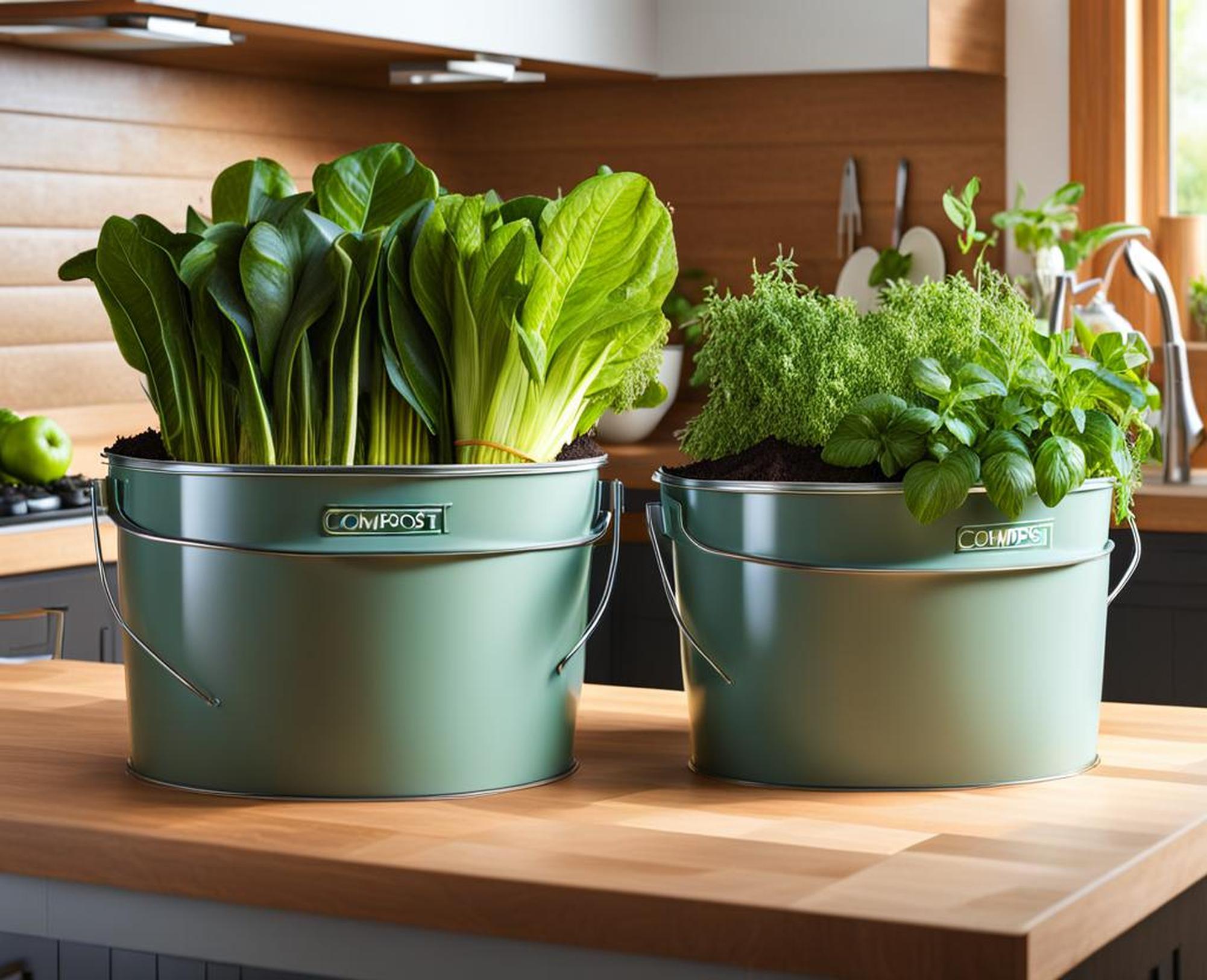If you’re looking to reduce your environmental impact and stop sending so much food waste to landfills, starting a simple composting system right in your own kitchen is a great idea. Collecting food scraps like vegetable peels, coffee grounds, and eggshells in a countertop compost bucket makes it easy to keep these materials out of the trash. But not all compost buckets are created equal when it comes to containing odors and pests while making compost collection convenient. Choosing the right compost bucket for your kitchen is the first step towards successful composting.
We’ll review top-rated buckets in different styles and price points. With the right compost bucket in place, you’ll be on your way to reaping all the environmental and gardening benefits of composting your food waste.
Benefits of Composting Food Scraps
Composting your food scraps provides some great advantages:
- Reduces the amount of organic waste sent to landfills. Food scraps make up a large portion of what we throw out.
- Produces nutrient-rich compost that can be used to fertilize gardens, houseplants, and lawns.
- Sustainably closes the food waste loop by returning nutrients to the soil.
By composting, you’re keeping valuable organic matter out of landfills so it can cycle back into the earth. Plus, making your own compost means you don’t have to buy chemical fertilizers.
Key Factors In Choosing a Kitchen Compost Bucket
Capacity
When selecting a countertop compost bucket, make sure to choose the right size for your household’s needs. The average 1.5-3 gallon bucket works well for most kitchens producing typical amounts of food waste. Larger households or avid cooks can look for bigger 5+ gallon bins to handle greater volumes.

If space is tight, compact under-sink buckets that slide into your cabinet keep the compost out of sight. Consider how often you want to empty the bucket to determine the ideal capacity.
Odor Control
One of the biggest concerns with kitchen composting is containing odors from decomposing food scraps. The best compost buckets use ventilation, activated charcoal filters, and tight-sealing lids to prevent smells.
Holes or mesh screens allow air flow so the bucket doesn’t trap moisture and bacteria that cause odors. Charcoal filters effectively absorb smells. Tight-fitting lids seal in odors when the bucket isn’t in use.
Fruit Fly Prevention
Exposed food waste can quickly attract pesky fruit flies. Quality compost buckets utilize fine mesh screens to keep flies and insects out of the compost while still allowing ventilation. Taking out the compost frequently before flies can breed also helps.
A tight seal and lid prevents flies from getting into the bucket. Closing the lid right after putting in scraps is crucial.
Ease of Cleaning
Over time, compost buckets can get dirty and smelly. Look for buckets with removable inner buckets, detachable parts like lids, and dishwasher-safe materials for easy cleaning.
Non-porous surfaces like stainless steel, durable plastic, and ceramic clean up better than materials like cloth or wicker that absorb odors and liquids.
Aesthetic Appeal
While functionality is most important, you don’t want an ugly compost bucket cluttering up your countertop. There are many stylish options available that add a decorative element to your kitchen.
Stainless steel buckets have a sleek, modern look. Plastic buckets come in various colors to coordinate with your kitchen’s decor. Some even resemble ceramic vases or crocks.
Reviews of Top Kitchen Compost Buckets
Now that you know what to look for in a compost bucket, let’s review some top options in different categories and price points.
Stainless Steel Buckets
OXO Good Grips
- Brushed stainless steel
- 2 gallon capacity
- Odor-blocking charcoal filter
- Easy-open fliptop lid
Enloy
- Fingerprint-proof stainless steel
- 1.3 gallon capacity
- Locking lid with charcoal filter
- Includes 10 compostable bags
Utopia Home
- Steel with copper finish
- 1.5 gallon capacity
- Detachable basket with handle
- Stylish accent for countertops
Plastic Buckets
OXO Good Grips
- Durable plastic
- 1.9 gallon capacity
- Odor-resistant
- Dishwasher safe
Kitchen Compost Crock
- BPA-free plastic
- 2 gallon capacity
- Decorative faux-stone look
- Angled opening and non-slip base
Busch Systems
- Molded recycled plastic
- 1.3 gallon capacity
- Locking lid and carrying handle
- Ventilated panels
Specialty Buckets
BioBag Kitchen Compost Bag Kit
- Includes compostable bag rolls
- Holds up to 3 gallons
- Features drainage tray
- Ideal for large volumes of scraps
Under-Sink Buckets
- Fits discreetly in cabinet
- 1.5-2 gallon capacity
- Plastic or stainless steel
- Great for small kitchens
Pro Tips for Odor and Pest Prevention
To keep unwanted smells and pests at bay, follow these pro tips:
- Empty the compost bucket frequently, every 2-3 days
- Line the bucket with BPI-certified compostable bags
- Rinse and scrub the bucket weekly
- Store the compost bucket outside to minimize odors
Taking out compost before it has a chance to rot is key. Using compostable bags also helps keeps things tidy.
Start Composting Your Food Scraps
Once you select the right indoor compost bucket, you’ll need a system for composting the collected scraps.
Many households compost food waste in outdoor piles they maintain themselves. Others find community compost drop-off programs through their municipality or local organizations.
If you want to compost indoors, special electric composters like the Lomi or Vitamix FoodCycler quickly break down scraps. While pricier, they’re very convenient options.
Choosing the composting method that works for your household is the next step after you implement a kitchen compost bucket. It’s easier to stay motivated when composting is quick and hassle-free.
A high-quality kitchen compost bucket is the cornerstone of any system for saving food scraps from the landfill. With features like odor control, fruit fly prevention, and easy cleaning, composting won’t dirty up your kitchen.
Reducing food waste sustainably starts right in your own home. Do your part for the planet and enrich your garden soil by composting your food scraps with the right compost bucket.
